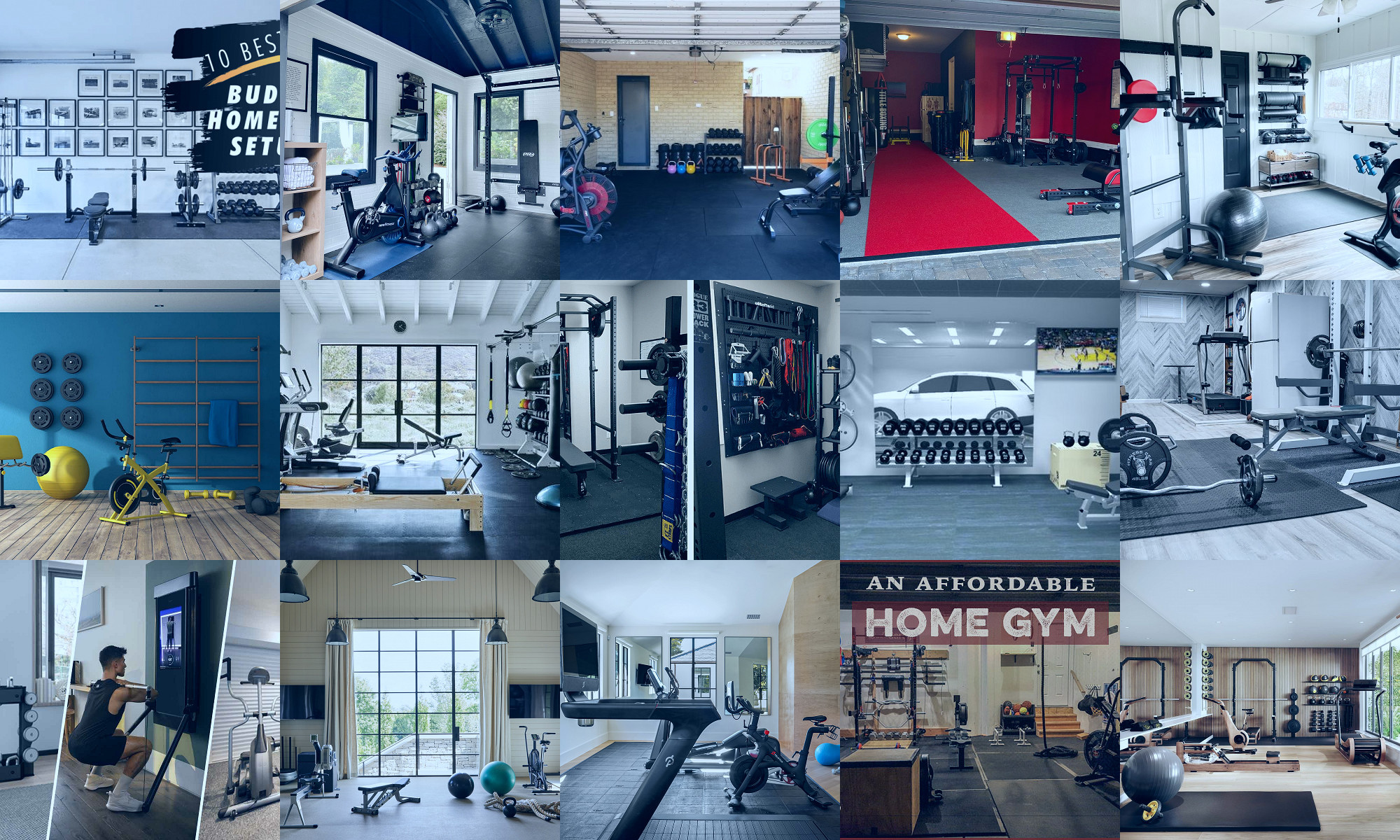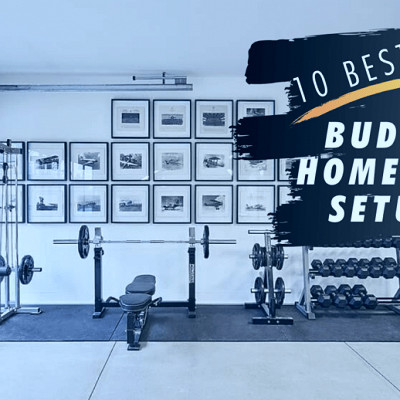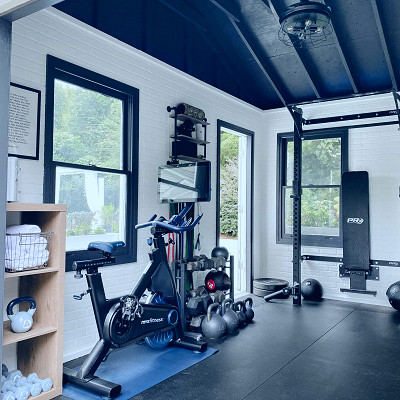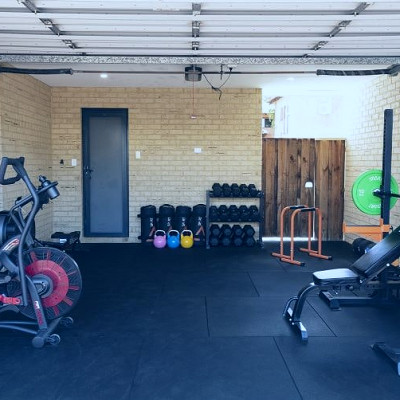 Jarlat Maletych/Shutterstock
Jarlat Maletych/Shutterstock
Features
The Concept of Home Gym
A home gym is a dedicated space within your living environment where you can exercise and keep fit. It can range from a simple setup with a few basic fitness tools to a fully-equipped, professional-grade workout space.
Understanding Your Fitness Goals
Before setting up a home gym, it's important to understand your fitness goals. Whether they involve losing weight, gaining muscle, increasing flexibility, or improving cardiovascular health, these objectives will guide your choice of workout equipment.
Space Allocation
The amount of space you have available will greatly influence your home gym setup. It is essential to allocate enough room for your equipment and for you to exercise comfortably, without risk of injury.
Essential Gym Equipment
Some of the fundamental gym equipment you might consider include dumbbells, kettlebells, resistance bands, a yoga mat, and a stability ball. These tools are versatile and can facilitate a wide range of exercises.
Cardio Machines
If you're aiming to improve your cardiovascular health or lose weight, cardio machines such as treadmills, stationary bikes, or elliptical trainers could be important additions to your home gym.
Strength Training Equipment
For muscle building and strength training, consider incorporating weightlifting equipment like barbells, weight plates, and weight benches.
Functional Training Tools
Equipment like medicine balls, battle ropes, and TRX suspension trainers can add variety to your workouts and help improve functional fitness, which is your ability to perform everyday activities safely and effectively.
Flooring Considerations
The right flooring can protect both your equipment and your floor from damage, reduce noise, and provide a more comfortable workout surface. Rubber or foam flooring are popular choices for home gyms.
Storage Solutions
Organizing your equipment with storage solutions like shelving units or racks can keep your workout space tidy and safe.
Home Gym Maintenance
Regular cleaning and maintenance of your home gym equipment will prolong their lifespan and ensure a safe, effective workout environment.
Proper Lighting
Good lighting is important in a home gym setup, as it can enhance your mood, improve safety, and assist performance.
Ventilation and Air Quality
Adequate ventilation and good air quality are crucial for a comfortable workout environment. Consider installing fans or air purifiers if necessary.
Gym Safety
Safety should be a top priority when setting up a home gym. This includes securing equipment properly, ensuring sufficient space for movement, and maintaining a clean, clutter-free environment.
Personalizing Your Space
Adding personal touches to your home gym like inspirational posters, a sound system, or a TV can make your workout sessions more enjoyable.
Fitness Tech
Incorporating fitness technology like heart rate monitors, fitness apps, or a smart speaker can help you track your progress and enhance your workouts.
Investing in Quality
While setting up a home gym can be cost-effective in the long run, it's important to invest in quality, durable equipment that will stand the test of time.
Professional Guidance
Consider seeking advice from fitness professionals when setting up your home gym. They can provide valuable insights on equipment selection, workout routines, and injury prevention.
Flexibility and Adaptability
Your home gym should be flexible and adaptable to accommodate your evolving fitness goals. This means choosing versatile equipment and planning your space so that it can be easily adjusted.
The Importance of Rest
Don't forget to include a rest area in your home gym. This could be a simple chair for taking breaks, or a foam roller and stretch mat for post-workout recovery.
The Commitment
Lastly, remember that setting up a home gym is a commitment to your health and wellbeing. Stay motivated, keep your workouts varied and fun, and you're likely to see the benefits of your investment.
Interesting notes and facts
1. The Flexibility of Home Workouts: A home gym setup allows for ultimate flexibility. Forget about gym timings or waiting for equipment. Your home gym, tailored to your needs, is available whenever you are. You can squeeze in an early morning workout, a late-night session, or even a quick mid-day break. It's your space, your rules.2. Customized for You: Unlike commercial gyms, home gyms can be custom-built according to your fitness goals. Whether you are into weight lifting, yoga, Pilates, or high-intensity interval training, your home gym can be equipped with just the right tools to facilitate your workout.
3. Privacy and Comfort: For many, the idea of working out in a crowded gym can be daunting. A home gym offers the privacy and comfort of exercising without feeling self-conscious. You can play your favorite music, wear what you want, and exercise at your own pace.
4. Cost-Efficient in the Long Run: The initial setup cost for a home gym can be a little high, but in the long run, it could save you money. Think about it - no more gym memberships, no commuting costs, and no need to buy expensive gym wear.
5. Promoting a Healthy Lifestyle: A home gym setup is more than just a space to exercise; it's a commitment to a healthier lifestyle. It's a constant, visible reminder to make healthy choices and stay active.
6. Family Fitness: A home gym can also be a great way to encourage family fitness. It provides a safe and convenient environment for your kids to understand the value of regular physical activity and can be a fun place for family workouts.
7. Multipurpose Space: Your home gym can double as a meditation or relaxation space. Install a yoga mat, some calming lights, and a sound system for a complete mind-body wellness experience right at home.
8. The Joy of Outdoor Workouts: If you've got a backyard, consider setting up part of your gym outdoors. Fresh air and sunshine can add a whole new dimension to your workout experience.
9. Tech-Savvy Fitness: With a home gym, you can make the most of fitness technology. From smart fitness equipment that tracks your progress to fitness apps that provide guided workouts, the possibilities are endless.
10. Creating a Sustainable Habit: Having a gym at home eliminates common excuses such as bad weather or lack of time, making it easier to stick to a regular exercise routine. It's a great way to create sustainable fitness habits that can last a lifetime.
Vocabulary
- Aerobic Exercise – A type of physical activity that uses large muscle groups, can be maintained continuously, and is rhythmic in nature.
- Anaerobic Exercise – Physical activity which is intense enough to trigger lactic acid formation, usually strength and resistance training.
- Antioxidants – Substances that can prevent or slow damage to cells caused by free radicals, unstable molecules that the body produces as a reaction to environmental and other pressures.
- Balanced Diet – A diet that gives your body the nutrients it needs to function correctly, usually consisting of the right balance of fruits, vegetables, protein, whole grains, and dairy.
- Barbell – A long metal bar to which discs of varying weights are attached at each end, used for weightlifting.
- Body Mass Index (BMI) – A measurement calculated using weight and height to categorize a person as underweight, normal weight, overweight, or obese.
- Calorie – The energy needed to raise the temperature of 1 gram of water by 1 °C, often used to measure the energy value of foods.
- Cardiovascular Exercise – Physical activity that raises your heart rate to improve your body's oxygen consumption.
- Dumbbell – A short bar with a weight at each end, used typically in pairs for exercise or muscle-building.
- Elliptical Machine – A stationary exercise machine used to simulate stair climbing, walking, or running without causing excessive pressure to the joints.
- Endurance – The ability of an organism to exert itself and remain active for a long period.
- Free Weights – Weights that aren't attached to a machine or device, such as dumbbells or barbells.
- Functional Training – A classification of exercise which involves training the body for the activities performed in daily life.
- High-Intensity Interval Training (HIIT) – A form of interval training, an exercise strategy alternating short periods of intense anaerobic exercise with less intense recovery periods.
- Hydration – The process of causing something to absorb water.
- Immunity – The ability of an organism to resist a particular infection or toxin by the action of specific antibodies or sensitized white blood cells.
- Interval Training – A type of training that involves a series of low- to high-intensity workouts interspersed with rest or relief periods.
- Kettlebell – A cast iron or cast steel ball with a handle attached to the top, used to perform many types of exercises, including ballistic exercises that combine cardiovascular, strength and flexibility training.
- Macronutrient – A type of food required in large amounts in the human diet, such as proteins, fats, and carbohydrates.
- Meditation – A practice where an individual uses a technique to achieve a mentally clear and emotionally calm and stable state.
- Micronutrient – A type of food required in small amounts in the human diet, such as vitamins and minerals.
- Nutrient Density – The amount of beneficial nutrients in a food product in relation to its calorie content.
- Omega-3 Fatty Acids – A type of fat that is beneficial for heart health, found in foods such as fish and flaxseed.
- Pilates – A system of exercises using special apparatus, designed to improve physical strength, flexibility, and posture, and enhance mental awareness.
- Plant-Based Diet – A diet consisting mostly or entirely of foods derived from plants, including vegetables, grains, nuts, seeds, legumes and fruits, and with few or no animal products.
- Probiotics – Live bacteria and yeasts that are good for your health, especially your digestive system.
- Resistance Training – A type of physical exercise specializing in the use of resistance to induce muscular contraction which builds the strength, anaerobic endurance, and size of skeletal muscles.
- Rest Day – A day when a person takes a break from their regular workout routine.
- Rowing Machine – An exercise machine that simulates the action of watercraft rowing for the purpose of exercise or training for rowing.
- Stationary Bike – An exercise machine that mimics the movement of riding a bicycle, usually used for cardiovascular fitness.
- Strength Training – A type of physical exercise specializing in the use of resistance to induce muscular contraction which builds the strength, anaerobic endurance, and size of skeletal muscles.
- Treadmill – An exercise machine for running or walking while staying in one place.
- Vegan Diet – A diet that excludes all animal products, including meat, dairy, and eggs.
- Vegetarian Diet – A diet that excludes meat, but may include other animal products like dairy and eggs.
- Vitamin – An organic molecule that is an essential micronutrient that an organism needs in small quantities for the proper functioning of its metabolism.
- Weightlifting – The activity of lifting heavy objects either as a sport or for exercise



